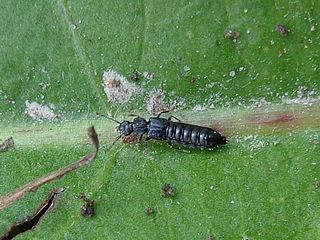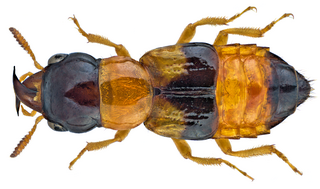
The rove beetles are a family (Staphylinidae) of beetles, primarily distinguished by their short elytra that typically leave more than half of their abdominal segments exposed. With over 66,000 species in thousands of genera, the group is the largest family in the beetle order, and one of the largest families of organisms. It is an ancient group, with fossilized rove beetles known from the Triassic, 200 million years ago, and possibly even earlier if the genus Leehermania proves to be a member of this family. They are an ecologically and morphologically diverse group of beetles, and commonly encountered in terrestrial ecosystems.

Pselaphinae are a subfamily of beetles in the family Staphylinidae, the rove beetles. The group was originally regarded as a separate family named Pselaphidae. Newton and Thayer (1995) placed them in the Omaliine group of the family Staphylinidae based on shared morphological characters.

Dasycerinae is a subfamily of rove beetles. Dasycerinae currently only contains 1 extant genus and 3 extinct genera.
The Empelinae are a subfamily of rove beetles ; their biology is virtually unknown. Their anatomy and ecology resemble many rove beetles.

The Oxytelinae are a subfamily of the Staphylinidae, rove beetles. There are about 20 genera and at least 320 described species in Oxytelinae.

Bledius is a genus of spiny-legged rove beetles in the family Staphylinidae. There are at least 100 described species in Bledius.
Osorius is a genus of unmargined rove beetles in the family Staphylinidae. There are about nine described species in Osorius.

Oxytelini is a tribe of spiny-legged rove beetles in the family Staphylinidae. There are about 11 genera and at least 20 described species in Oxytelini.
Bledius fenyesi is a species of insect in the subfamily Oxytelinae and in the family Staphylinidae. It is found in Central America and North America.
Bledius philadelphicus is a species of spiny-legged rove beetle in the family Staphylinidae. It is found in North America.

Lithocharis is a genus of rove beetles in the family Staphylinidae.

Oxyporus rufus is a species of beetle belonging to the large family of the rove beetles (Staphylinidae).
Anotylus latiusculus is a species of rove beetle widely spread in Asia.
Oxytelus bengalensis is a species of rove beetle widely spread in Asia. It is found in China, Hong Kong, South Korea, Japan, Vietnam, Laos, Myanmar, Thailand, Malaysia, Singapore, Bangladesh, Sri Lanka, Nepal, Pakistan and India.
Oxytelus migrator is a species of rove beetle widely spread in Asia and Europe. It is found in China, Hong Kong, Japan, Vietnam, Thailand, Malaysia, Indonesia, and Sri Lanka.
Oxytelus incisus is a species of rove beetle with cosmopolitan distribution across the continents.
Oxytelus nigriceps is a species of rove beetle widely spread in Asia. It is found in China, Hong Kong, South Korea, Japan, Philippines, Vietnam, Thailand, Myanmar, Malaysia, Singapore, Indonesia, New Guinea, Bismarck Islands, Pakistan, India, Nepal, Sri Lanka, and Bangladesh.
Oxytelus puncticeps is a species of rove beetle widely spread in Asia and Africa. It is found in China, Hong Kong, Taiwan, Japan, Philippines, Vietnam, Indonesia, Borneo, Sri Lanka, India, and Sub-Saharan Africa.
Stenus solutus is a species of rove beetle widely spread in Asia and England.
Coomania tonkinensis is a species of beetle of the Staphylinidae family, Staphylininae subfamily. It was first described by Malcolm Cameron to the tribe Diochini, but in 2020 moved to its own tribe Coomaniini. The species is found in Vietnam and Sabah, Malaysia.







